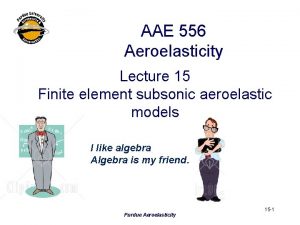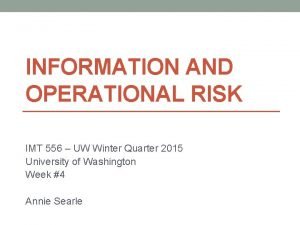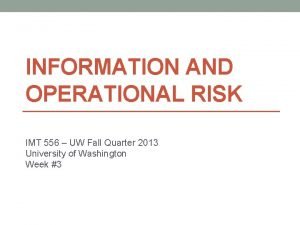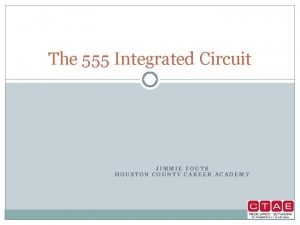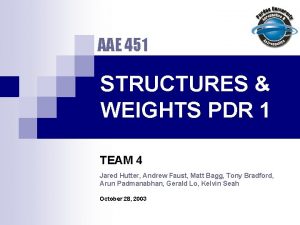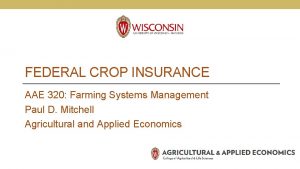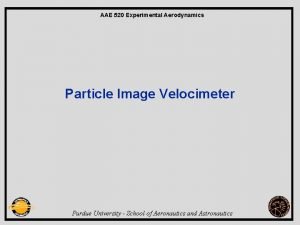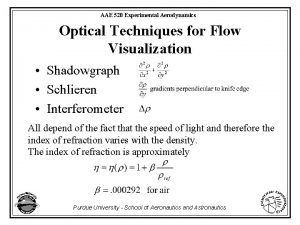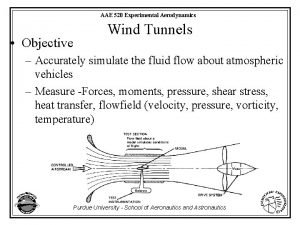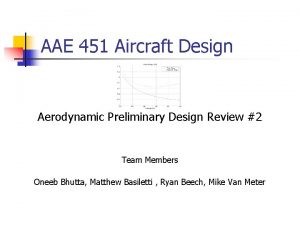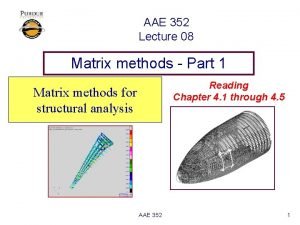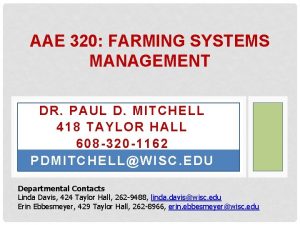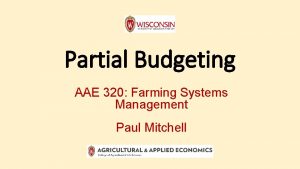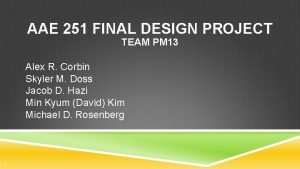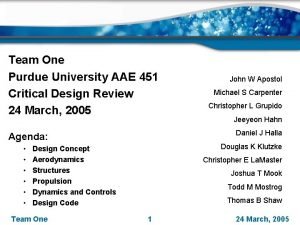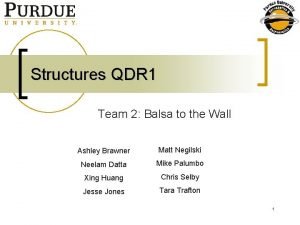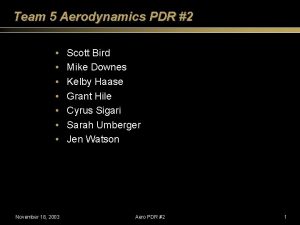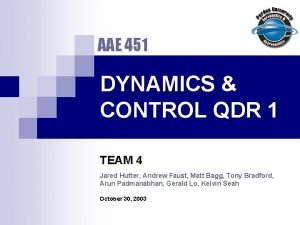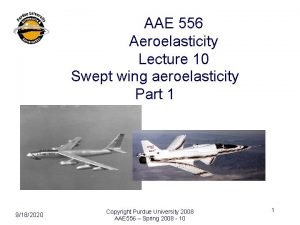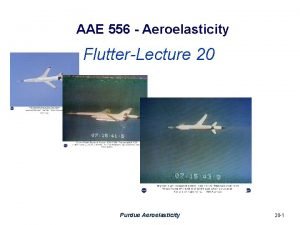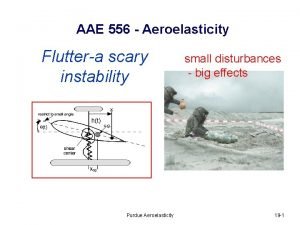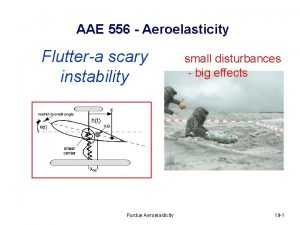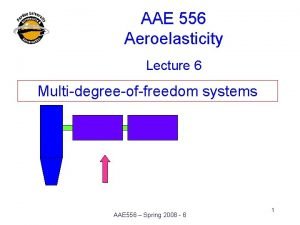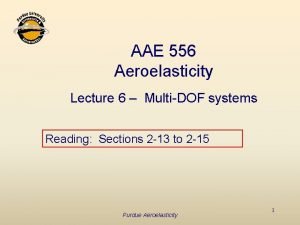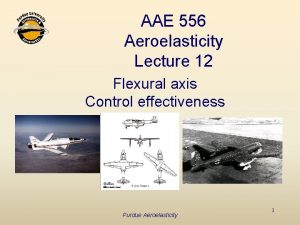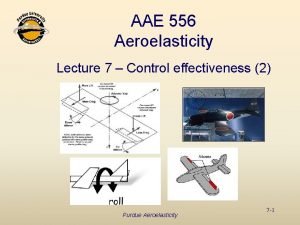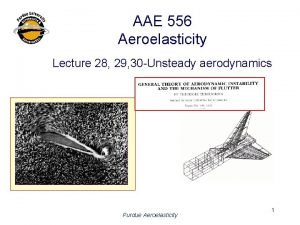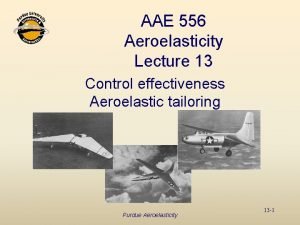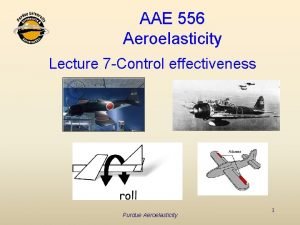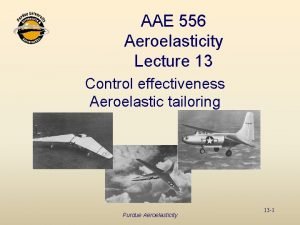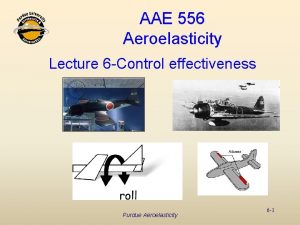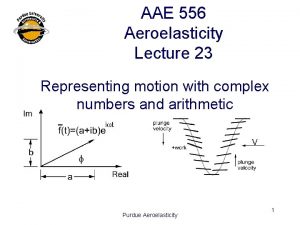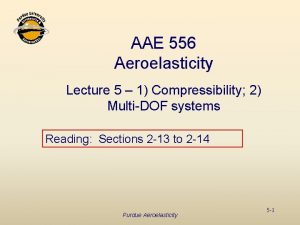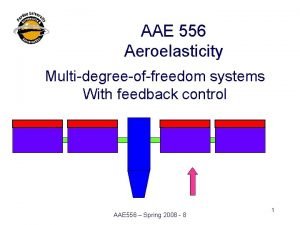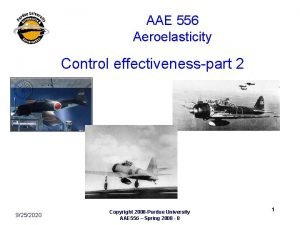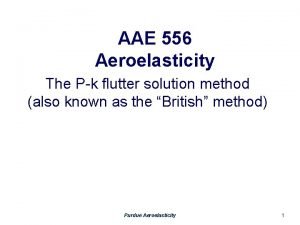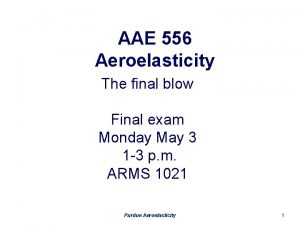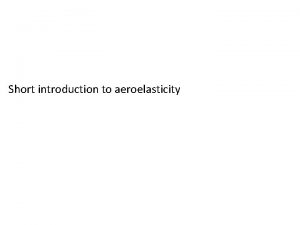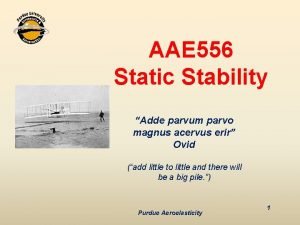AAE 556 Aeroelasticity Lecture 4 Reading notes assignment

























- Slides: 25

AAE 556 Aeroelasticity Lecture 4 Reading: notes assignment from Lecture 3 weisshaar@purdue. edu Armstrong 3329 765 -494 -5975 Purdue Aeroelasticity 4 -1

Summary to-date i Development of simple models of wing aeroelastic behavior with pitch (torsion) only and pitch and plunge (bending) i Models show that torsional deformation creates additional lift, deflection (and stress). i Models identify an aeroelastic parameter that defines a dynamic pressure at which lift and torsional deflection approach infinity – Models are linear so this will never really happen – This special dynamic pressure is called the “divergence dynamic pressure. ” Purdue Aeroelasticity 4 -2

Today and next week’s agenda i Define and discuss static stability – Concept of perturbations – Distinguish stability from response i Learn how to do a stability analysis i Find the divergence dynamic pressure using a “perturbation” analysis Purdue Aeroelasticity 4 -3

The perturbed structure i Static stability analysis considers what happens to a flexible system that is in static equilibrium and is then disturbed. – If the system tends to come back to its original, undisturbed position, it is stable - if not - it is unstable. i We need to apply these above words to equations so that we can put the aeroelastic system to a mathematical test Purdue Aeroelasticity 4 -4

Stability investigation i Given a system that we know is in static equilibrium (forces and moments sum to zero) i Add a disturbance to perturb the system to move it to a different, nearby position (that may or may not be in static equilibrium) i Is this new, nearby state also a static equilibrium point? i Write static equilibrium equations and see if forces and moments balance Purdue Aeroelasticity 4 -5

Perturbed airfoil i In flight this airfoil is in static equilibrium at the fixed angle q but what happens if we disturb (perturb) it? i There are three possibilities Purdue Aeroelasticity 4 -6

Perturbation possibilities i KT(Dq)>(DL)e – statically stable because it tends to return – no static equilibrium in the perturbed state i KT(Dq)<(DL)e – statically unstable – motion away from original position i KT(Dq)=(DL)e – system stays perturbed but static – we have found new static equilibrium point – Euler test has found neutral stability Purdue Aeroelasticity 4 -7

Example i Perturb the airfoil when it is in static equilibrium i To be neutrally stable in this new perturbed position this equation must be an true Purdue Aeroelasticity 4 -8

Static stability investigation is “stiffness based” Neutral stability means this relationship must be zero (2 states) so. . . Not zero condition at neutral stability static equilibrium displacement (Dq) is not unique Purdue Aeroelasticity 4 -9

Observations i The equation for neutral stability is simply the usual static equilibrium equation with right-handside (the input angle ao) set to zero. i The neutral stability equation describes a special case – only deformation dependent external (aero) and internal (structural) loads are present – these loads are “self-equilibrating” without any other action being taken Purdue Aeroelasticity 4 -10

Stability investigation i Take a system that we know is in static equilibrium (forces and moments sum to zero) i Perturb the system to move it to a different, nearby position (that may or may not be in static equilibrium) i Is this new, nearby state also a static equilibrium point? i Static equilibrium equations for stability are those for a self-equilibrating 11 system Purdue Aeroelasticity

More observations i At neutral stability the deformation is not unique (Dq is not zero but can be plus or minus) i At neutral static stability the system has many choices (equilibrium states) near its original equilibrium state. – airfoil position is uncontrollable - it has no displacement preference when a load is applied. Purdue Aeroelasticity 4 -12

The 1 DOF divergence condition i Neutral stability i or Purdue Aeroelasticity 4 -13

System stiffness, not strength, is important Structural resistance Aero overturning Slope depends on q. SCLa Equilibrium point Purdue Aeroelasticity 4 -14

Stable perturbed system Equilibrium point Purdue Aeroelasticity 4 -15

Perturbed system-neutral stability Lines are parallel Equilibrium point at infinity Purdue Aeroelasticity 4 -16

Unstable system Equilibrium point? Purdue Aeroelasticity 4 -17

Aeroelastic stiffness decreases as q increases Purdue Aeroelasticity 4 -18

Aeroelastic divergence i Look at the single degree of freedom typical section and the expression for twist angle with the initial load i neglect wing camber previous result "twist amplification" Purdue Aeroelasticity 4 -19

Twist amplification Purdue Aeroelasticity 4 -20

Example corrections q bar = 0. 5 relative sizes of terms the sum of the terms is 2 Purdue Aeroelasticity 4 -21

Aeroelastic feedback process qo is the twist angle with no aero load/structural response "feedback" Purdue Aeroelasticity 4 -22

More terms the response to angle of attack qo instead of ao …and, the third term Purdue Aeroelasticity 4 -23

Conclusion Each term in the series represents a feedback "correction" to the twist created by load interaction Series convergence Series divergence Purdue Aeroelasticity 4 -24

Summary i Divergence condition is a neutral stability condition i Divergence condition can be found using the original equilibrium conditions i Stability does not depend on the value of the applied loads Purdue Aeroelasticity 4 -25
 Subsonic 556
Subsonic 556 01:640:244 lecture notes - lecture 15: plat, idah, farad
01:640:244 lecture notes - lecture 15: plat, idah, farad National weather service forecast
National weather service forecast Po box 30512 salt lake city
Po box 30512 salt lake city Imt 556
Imt 556 556 pwm circuit
556 pwm circuit While reading activities
While reading activities Aae 508 purdue
Aae 508 purdue Aae 320
Aae 320 Aae 520
Aae 520 Aae 520
Aae 520 Aae 520
Aae 520 Aae design
Aae design Aae 352
Aae 352 Aae 320
Aae 320 Aae 320
Aae 320 Aae 251
Aae 251 One.purdue
One.purdue Aae glass tutorial
Aae glass tutorial Aae 421
Aae 421 Aae 421
Aae 421 Project procurement management lecture notes
Project procurement management lecture notes Theology proper lecture notes
Theology proper lecture notes Introduction to public sector accounting
Introduction to public sector accounting Project management lecture notes
Project management lecture notes Electricity and magnetism lecture notes
Electricity and magnetism lecture notes
